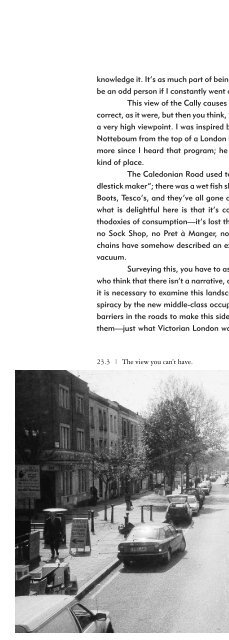The Unknown City: Contesting Architecture and Social Space
The Unknown City: Contesting Architecture and Social Space The Unknown City: Contesting Architecture and Social Space
Journeys on the Caledonian Road knowledge it. It’s as much part of being in a city as anything else, but I would be an odd person if I constantly went out and beat the bounds of the prison. This view of the Cally causes even me to check; it’s topographically correct, as it were, but then you think, “Hey, this guy’s going to die”; it’s from a very high viewpoint. I was inspired by a fantastic radio broadcast by Kees Notteboum from the top of a London bus. I’ve used the top of the bus much more since I heard that program; he reminded me that it’s a very specific kind of place. The Caledonian Road used to be much more “butcher, baker, candlestick maker”; there was a wet fish shop here, a decent baker, Woolworth’s, Boots, Tesco’s, and they’ve all gone as they have in the whole country. But what is delightful here is that it’s completely without any of the new orthodoxies of consumption—it’s lost the old ones, but there’s no Body Shop, no Sock Shop, no Pret à Manger, nobody wants to come here. The retail chains have somehow described an exclusion zone. The Cally hovers in the vacuum. Surveying this, you have to ask who owns what and why. For people who think that there isn’t a narrative, or that you shouldn’t speak narratively, it is necessary to examine this landscape. You have here a circa 1972 conspiracy by the new middle-class occupiers of these residential streets to put barriers in the roads to make this side belong to us, and that side belong to them—just what Victorian London was like, I understand. Then you’ve got 23.3 | The view you can’t have.
- Page 790: 21.5 | Site plan, Embassy project,
- Page 794: Notes This chapter is based on a pr
- Page 798: William Menking: I want to ask you
- Page 802: Architecture and the City tions bet
- Page 806: 22.4 | Parc de la Villette, Paris.
- Page 810: Architecture and the City precisely
- Page 814: Architecture and the City technolog
- Page 818: Architecture and the City WM: You a
- Page 822: Architecture and the City find in i
- Page 826: Note Bernard Tschumi was interviewe
- Page 830: Artist Richard Wentworth has lived
- Page 834: 23.2 | The parallels of art and lif
- Page 838: value there, and while there are co
- Page 844: Part III: Tactics 394 23 395 23.4 g
- Page 848: Part III: Tactics 396 23 397 Richar
- Page 852: Part III: Tactics 398 23 399 23.8 z
- Page 856: 23.10 | The afterlife of objects. 2
- Page 860: Part III: Tactics 402 23 403 Richar
- Page 864: Part III: Tactics 404 23 405 Richar
- Page 868: Part IV Tactical Filters
- Page 872: Iain Chambers The event of dwelling
- Page 876: Part IV: Tactical Filters 410 24 41
- Page 880: Part IV: Tactical Filters 412 24 41
- Page 884: Part IV: Tactical Filters 414 24 41
- Page 888: Part IV: Tactical Filters 416 24 41
Journeys on the Caledonian Road<br />
knowledge it. It’s as much part of being in a city as anything else, but I would<br />
be an odd person if I constantly went out <strong>and</strong> beat the bounds of the prison.<br />
This view of the Cally causes even me to check; it’s topographically<br />
correct, as it were, but then you think, “Hey, this guy’s going to die”; it’s from<br />
a very high viewpoint. I was inspired by a fantastic radio broadcast by Kees<br />
Notteboum from the top of a London bus. I’ve used the top of the bus much<br />
more since I heard that program; he reminded me that it’s a very specific<br />
kind of place.<br />
<strong>The</strong> Caledonian Road used to be much more “butcher, baker, c<strong>and</strong>lestick<br />
maker”; there was a wet fish shop here, a decent baker, Woolworth’s,<br />
Boots, Tesco’s, <strong>and</strong> they’ve all gone as they have in the whole country. But<br />
what is delightful here is that it’s completely without any of the new orthodoxies<br />
of consumption—it’s lost the old ones, but there’s no Body Shop,<br />
no Sock Shop, no Pret à Manger, nobody wants to come here. <strong>The</strong> retail<br />
chains have somehow described an exclusion zone. <strong>The</strong> Cally hovers in the<br />
vacuum.<br />
Surveying this, you have to ask who owns what <strong>and</strong> why. For people<br />
who think that there isn’t a narrative, or that you shouldn’t speak narratively,<br />
it is necessary to examine this l<strong>and</strong>scape. You have here a circa 1972 conspiracy<br />
by the new middle-class occupiers of these residential streets to put<br />
barriers in the roads to make this side belong to us, <strong>and</strong> that side belong to<br />
them—just what Victorian London was like, I underst<strong>and</strong>. <strong>The</strong>n you’ve got<br />
23.3 | <strong>The</strong> view you can’t have.



